Curtain Co. Network Framework: Data Processing and Network Services
VerifiedAdded on 2023/06/15
|11
|4022
|300
Report
AI Summary
This report outlines a network framework for Curtain Co., addressing issues stemming from improper technology implementation. It emphasizes key factors for building a robust network infrastructure, including a detailed diagram of an appropriate structure. The report evaluates data processing solutions, network infrastructure components (LAN, WAN, IP & DNS Management, Network Convergence and Unified Communications) and network services (VoIP, Email, Extranet, SNMP), recommending optimal solutions based on the organization's requirements and past experiences. The recommendations prioritize benefits and the specific needs of Curtain Co., aiming to enhance communication, security, and data management across its geographically dispersed units.

Curtain Co. Network Framework
Name of the Student
Name of the University
Author Note
Name of the Student
Name of the University
Author Note
Paraphrase This Document
Need a fresh take? Get an instant paraphrase of this document with our AI Paraphraser
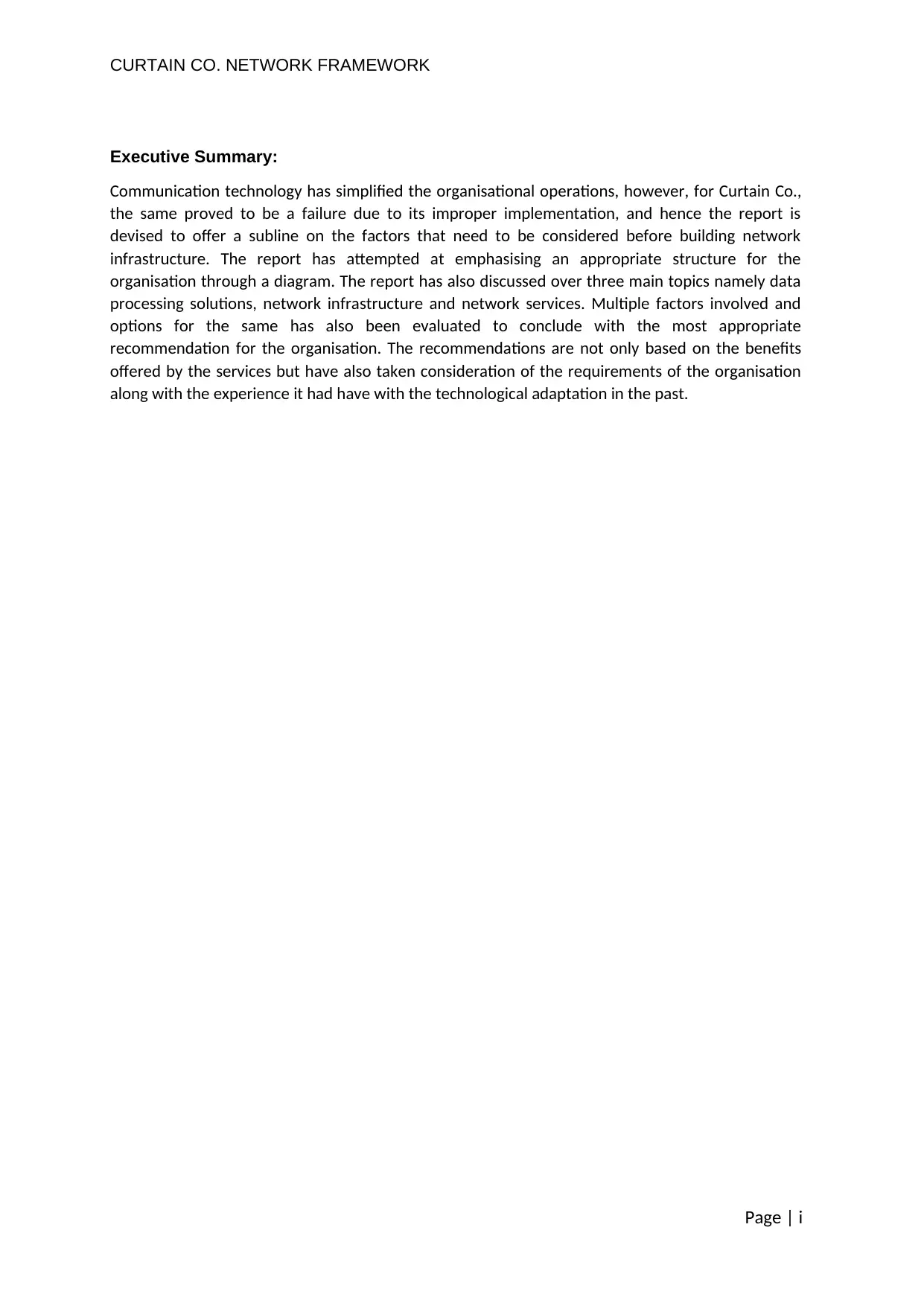
CURTAIN CO. NETWORK FRAMEWORK
Executive Summary:
Communication technology has simplified the organisational operations, however, for Curtain Co.,
the same proved to be a failure due to its improper implementation, and hence the report is
devised to offer a subline on the factors that need to be considered before building network
infrastructure. The report has attempted at emphasising an appropriate structure for the
organisation through a diagram. The report has also discussed over three main topics namely data
processing solutions, network infrastructure and network services. Multiple factors involved and
options for the same has also been evaluated to conclude with the most appropriate
recommendation for the organisation. The recommendations are not only based on the benefits
offered by the services but have also taken consideration of the requirements of the organisation
along with the experience it had have with the technological adaptation in the past.
Page | i
Executive Summary:
Communication technology has simplified the organisational operations, however, for Curtain Co.,
the same proved to be a failure due to its improper implementation, and hence the report is
devised to offer a subline on the factors that need to be considered before building network
infrastructure. The report has attempted at emphasising an appropriate structure for the
organisation through a diagram. The report has also discussed over three main topics namely data
processing solutions, network infrastructure and network services. Multiple factors involved and
options for the same has also been evaluated to conclude with the most appropriate
recommendation for the organisation. The recommendations are not only based on the benefits
offered by the services but have also taken consideration of the requirements of the organisation
along with the experience it had have with the technological adaptation in the past.
Page | i
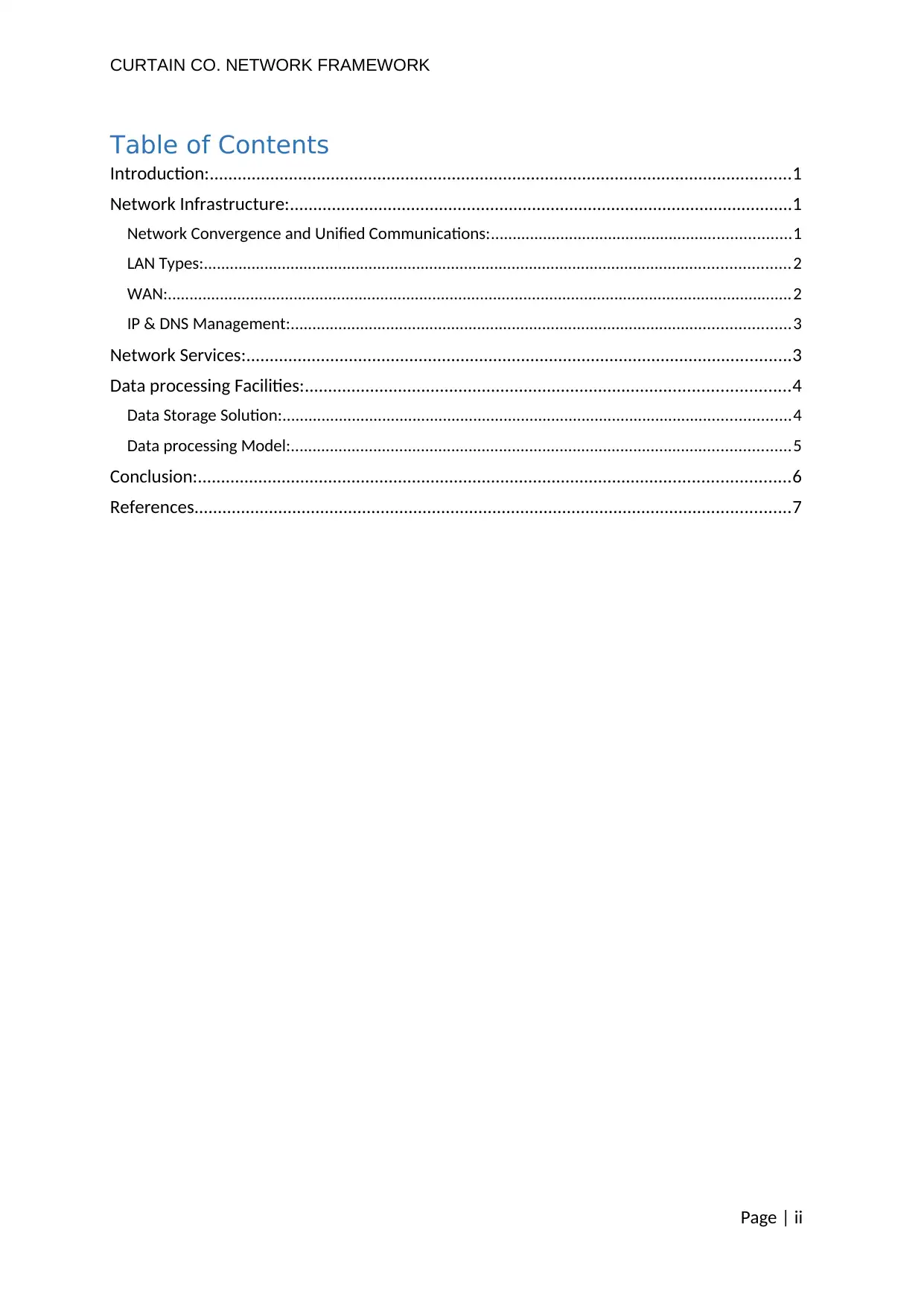
CURTAIN CO. NETWORK FRAMEWORK
Table of Contents
Introduction:.............................................................................................................................1
Network Infrastructure:............................................................................................................1
Network Convergence and Unified Communications:.....................................................................1
LAN Types:.......................................................................................................................................2
WAN:................................................................................................................................................2
IP & DNS Management:...................................................................................................................3
Network Services:.....................................................................................................................3
Data processing Facilities:........................................................................................................4
Data Storage Solution:.....................................................................................................................4
Data processing Model:...................................................................................................................5
Conclusion:...............................................................................................................................6
References................................................................................................................................7
Page | ii
Table of Contents
Introduction:.............................................................................................................................1
Network Infrastructure:............................................................................................................1
Network Convergence and Unified Communications:.....................................................................1
LAN Types:.......................................................................................................................................2
WAN:................................................................................................................................................2
IP & DNS Management:...................................................................................................................3
Network Services:.....................................................................................................................3
Data processing Facilities:........................................................................................................4
Data Storage Solution:.....................................................................................................................4
Data processing Model:...................................................................................................................5
Conclusion:...............................................................................................................................6
References................................................................................................................................7
Page | ii
⊘ This is a preview!⊘
Do you want full access?
Subscribe today to unlock all pages.

Trusted by 1+ million students worldwide
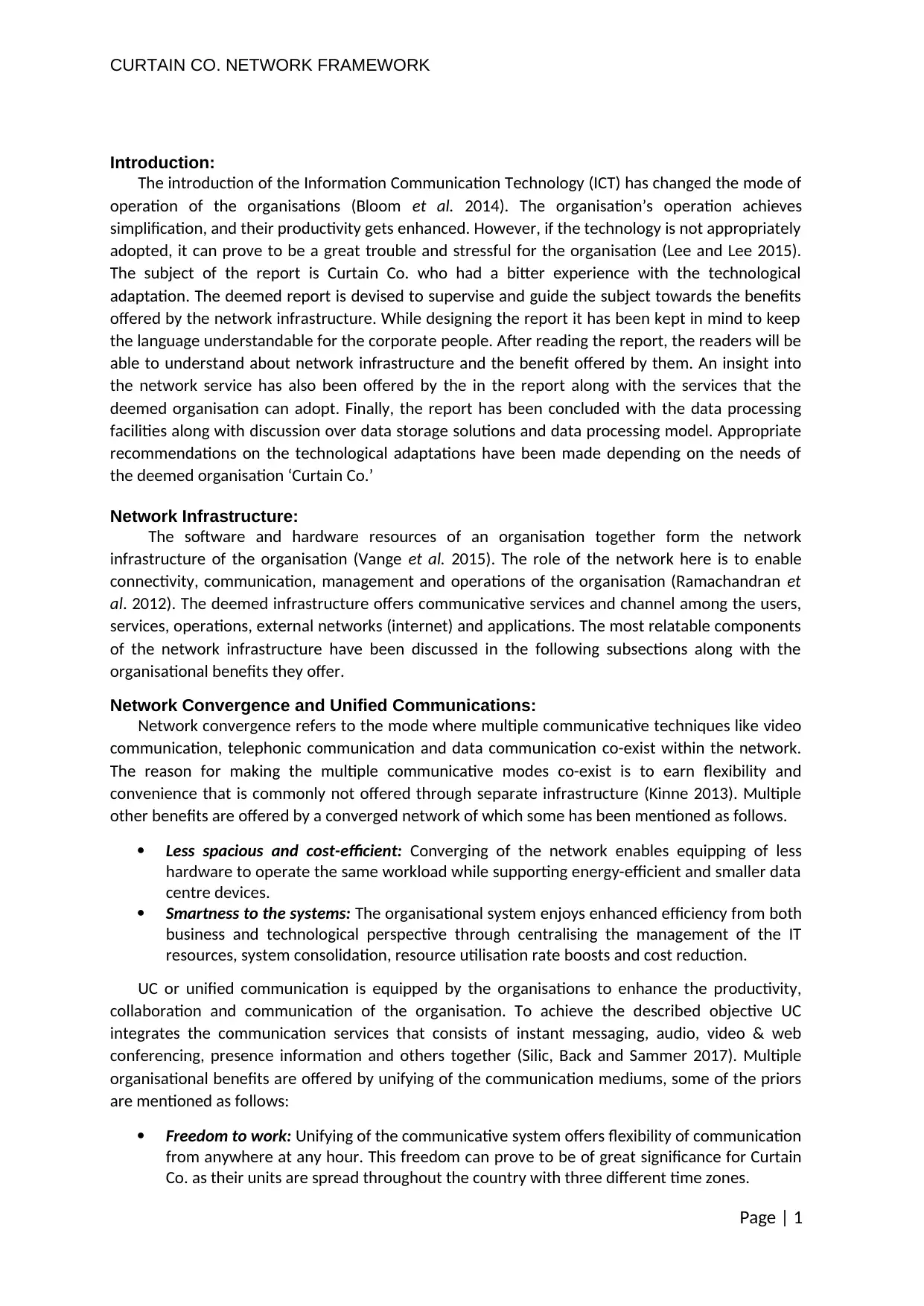
CURTAIN CO. NETWORK FRAMEWORK
Introduction:
The introduction of the Information Communication Technology (ICT) has changed the mode of
operation of the organisations (Bloom et al. 2014). The organisation’s operation achieves
simplification, and their productivity gets enhanced. However, if the technology is not appropriately
adopted, it can prove to be a great trouble and stressful for the organisation (Lee and Lee 2015).
The subject of the report is Curtain Co. who had a bitter experience with the technological
adaptation. The deemed report is devised to supervise and guide the subject towards the benefits
offered by the network infrastructure. While designing the report it has been kept in mind to keep
the language understandable for the corporate people. After reading the report, the readers will be
able to understand about network infrastructure and the benefit offered by them. An insight into
the network service has also been offered by the in the report along with the services that the
deemed organisation can adopt. Finally, the report has been concluded with the data processing
facilities along with discussion over data storage solutions and data processing model. Appropriate
recommendations on the technological adaptations have been made depending on the needs of
the deemed organisation ‘Curtain Co.’
Network Infrastructure:
The software and hardware resources of an organisation together form the network
infrastructure of the organisation (Vange et al. 2015). The role of the network here is to enable
connectivity, communication, management and operations of the organisation (Ramachandran et
al. 2012). The deemed infrastructure offers communicative services and channel among the users,
services, operations, external networks (internet) and applications. The most relatable components
of the network infrastructure have been discussed in the following subsections along with the
organisational benefits they offer.
Network Convergence and Unified Communications:
Network convergence refers to the mode where multiple communicative techniques like video
communication, telephonic communication and data communication co-exist within the network.
The reason for making the multiple communicative modes co-exist is to earn flexibility and
convenience that is commonly not offered through separate infrastructure (Kinne 2013). Multiple
other benefits are offered by a converged network of which some has been mentioned as follows.
Less spacious and cost-efficient: Converging of the network enables equipping of less
hardware to operate the same workload while supporting energy-efficient and smaller data
centre devices.
Smartness to the systems: The organisational system enjoys enhanced efficiency from both
business and technological perspective through centralising the management of the IT
resources, system consolidation, resource utilisation rate boosts and cost reduction.
UC or unified communication is equipped by the organisations to enhance the productivity,
collaboration and communication of the organisation. To achieve the described objective UC
integrates the communication services that consists of instant messaging, audio, video & web
conferencing, presence information and others together (Silic, Back and Sammer 2017). Multiple
organisational benefits are offered by unifying of the communication mediums, some of the priors
are mentioned as follows:
Freedom to work: Unifying of the communicative system offers flexibility of communication
from anywhere at any hour. This freedom can prove to be of great significance for Curtain
Co. as their units are spread throughout the country with three different time zones.
Page | 1
Introduction:
The introduction of the Information Communication Technology (ICT) has changed the mode of
operation of the organisations (Bloom et al. 2014). The organisation’s operation achieves
simplification, and their productivity gets enhanced. However, if the technology is not appropriately
adopted, it can prove to be a great trouble and stressful for the organisation (Lee and Lee 2015).
The subject of the report is Curtain Co. who had a bitter experience with the technological
adaptation. The deemed report is devised to supervise and guide the subject towards the benefits
offered by the network infrastructure. While designing the report it has been kept in mind to keep
the language understandable for the corporate people. After reading the report, the readers will be
able to understand about network infrastructure and the benefit offered by them. An insight into
the network service has also been offered by the in the report along with the services that the
deemed organisation can adopt. Finally, the report has been concluded with the data processing
facilities along with discussion over data storage solutions and data processing model. Appropriate
recommendations on the technological adaptations have been made depending on the needs of
the deemed organisation ‘Curtain Co.’
Network Infrastructure:
The software and hardware resources of an organisation together form the network
infrastructure of the organisation (Vange et al. 2015). The role of the network here is to enable
connectivity, communication, management and operations of the organisation (Ramachandran et
al. 2012). The deemed infrastructure offers communicative services and channel among the users,
services, operations, external networks (internet) and applications. The most relatable components
of the network infrastructure have been discussed in the following subsections along with the
organisational benefits they offer.
Network Convergence and Unified Communications:
Network convergence refers to the mode where multiple communicative techniques like video
communication, telephonic communication and data communication co-exist within the network.
The reason for making the multiple communicative modes co-exist is to earn flexibility and
convenience that is commonly not offered through separate infrastructure (Kinne 2013). Multiple
other benefits are offered by a converged network of which some has been mentioned as follows.
Less spacious and cost-efficient: Converging of the network enables equipping of less
hardware to operate the same workload while supporting energy-efficient and smaller data
centre devices.
Smartness to the systems: The organisational system enjoys enhanced efficiency from both
business and technological perspective through centralising the management of the IT
resources, system consolidation, resource utilisation rate boosts and cost reduction.
UC or unified communication is equipped by the organisations to enhance the productivity,
collaboration and communication of the organisation. To achieve the described objective UC
integrates the communication services that consists of instant messaging, audio, video & web
conferencing, presence information and others together (Silic, Back and Sammer 2017). Multiple
organisational benefits are offered by unifying of the communication mediums, some of the priors
are mentioned as follows:
Freedom to work: Unifying of the communicative system offers flexibility of communication
from anywhere at any hour. This freedom can prove to be of great significance for Curtain
Co. as their units are spread throughout the country with three different time zones.
Page | 1
Paraphrase This Document
Need a fresh take? Get an instant paraphrase of this document with our AI Paraphraser
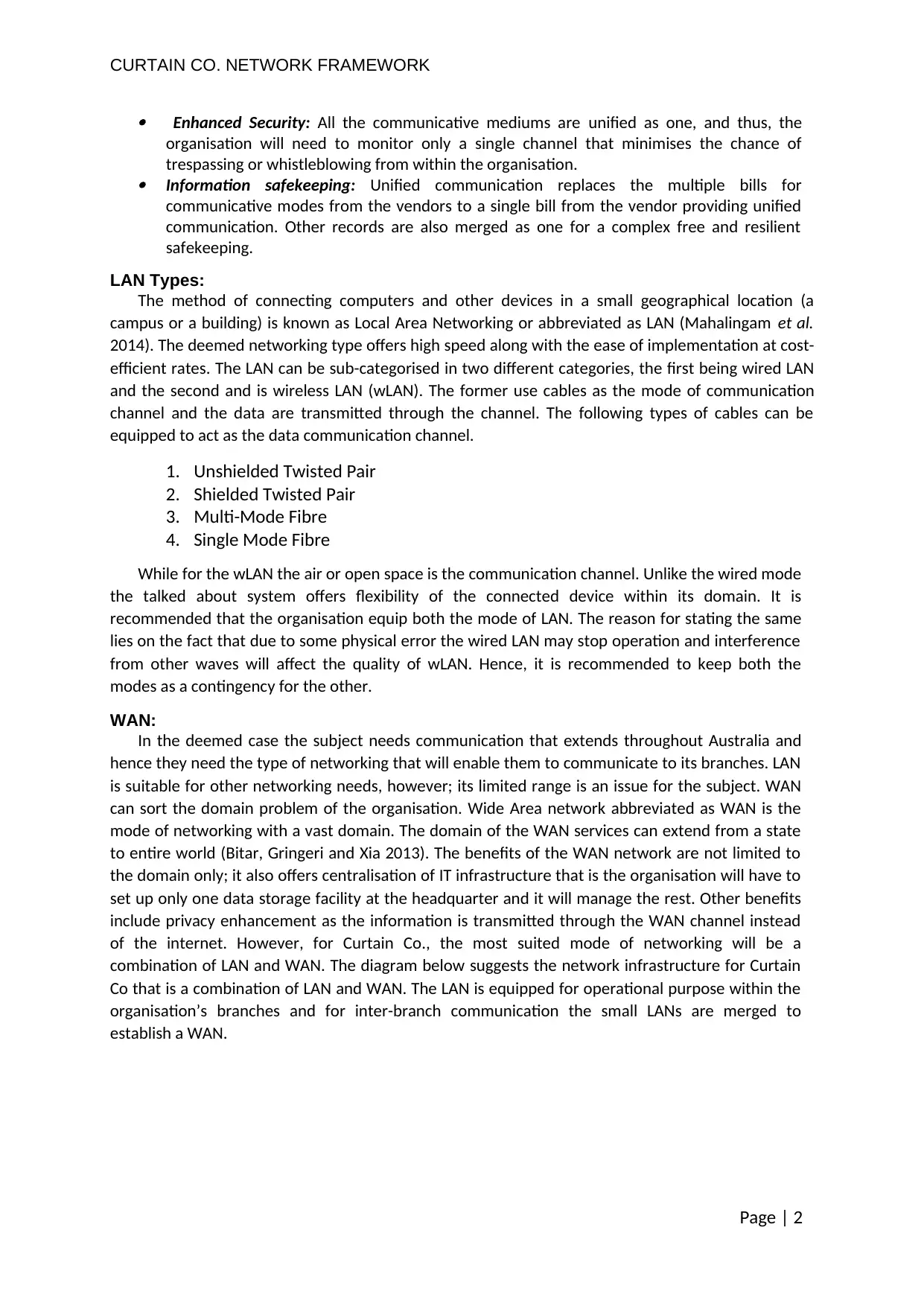
CURTAIN CO. NETWORK FRAMEWORK
Enhanced Security: All the communicative mediums are unified as one, and thus, the
organisation will need to monitor only a single channel that minimises the chance of
trespassing or whistleblowing from within the organisation.
Information safekeeping: Unified communication replaces the multiple bills for
communicative modes from the vendors to a single bill from the vendor providing unified
communication. Other records are also merged as one for a complex free and resilient
safekeeping.
LAN Types:
The method of connecting computers and other devices in a small geographical location (a
campus or a building) is known as Local Area Networking or abbreviated as LAN (Mahalingam et al.
2014). The deemed networking type offers high speed along with the ease of implementation at cost-
efficient rates. The LAN can be sub-categorised in two different categories, the first being wired LAN
and the second and is wireless LAN (wLAN). The former use cables as the mode of communication
channel and the data are transmitted through the channel. The following types of cables can be
equipped to act as the data communication channel.
1. Unshielded Twisted Pair
2. Shielded Twisted Pair
3. Multi-Mode Fibre
4. Single Mode Fibre
While for the wLAN the air or open space is the communication channel. Unlike the wired mode
the talked about system offers flexibility of the connected device within its domain. It is
recommended that the organisation equip both the mode of LAN. The reason for stating the same
lies on the fact that due to some physical error the wired LAN may stop operation and interference
from other waves will affect the quality of wLAN. Hence, it is recommended to keep both the
modes as a contingency for the other.
WAN:
In the deemed case the subject needs communication that extends throughout Australia and
hence they need the type of networking that will enable them to communicate to its branches. LAN
is suitable for other networking needs, however; its limited range is an issue for the subject. WAN
can sort the domain problem of the organisation. Wide Area network abbreviated as WAN is the
mode of networking with a vast domain. The domain of the WAN services can extend from a state
to entire world (Bitar, Gringeri and Xia 2013). The benefits of the WAN network are not limited to
the domain only; it also offers centralisation of IT infrastructure that is the organisation will have to
set up only one data storage facility at the headquarter and it will manage the rest. Other benefits
include privacy enhancement as the information is transmitted through the WAN channel instead
of the internet. However, for Curtain Co., the most suited mode of networking will be a
combination of LAN and WAN. The diagram below suggests the network infrastructure for Curtain
Co that is a combination of LAN and WAN. The LAN is equipped for operational purpose within the
organisation’s branches and for inter-branch communication the small LANs are merged to
establish a WAN.
Page | 2
Enhanced Security: All the communicative mediums are unified as one, and thus, the
organisation will need to monitor only a single channel that minimises the chance of
trespassing or whistleblowing from within the organisation.
Information safekeeping: Unified communication replaces the multiple bills for
communicative modes from the vendors to a single bill from the vendor providing unified
communication. Other records are also merged as one for a complex free and resilient
safekeeping.
LAN Types:
The method of connecting computers and other devices in a small geographical location (a
campus or a building) is known as Local Area Networking or abbreviated as LAN (Mahalingam et al.
2014). The deemed networking type offers high speed along with the ease of implementation at cost-
efficient rates. The LAN can be sub-categorised in two different categories, the first being wired LAN
and the second and is wireless LAN (wLAN). The former use cables as the mode of communication
channel and the data are transmitted through the channel. The following types of cables can be
equipped to act as the data communication channel.
1. Unshielded Twisted Pair
2. Shielded Twisted Pair
3. Multi-Mode Fibre
4. Single Mode Fibre
While for the wLAN the air or open space is the communication channel. Unlike the wired mode
the talked about system offers flexibility of the connected device within its domain. It is
recommended that the organisation equip both the mode of LAN. The reason for stating the same
lies on the fact that due to some physical error the wired LAN may stop operation and interference
from other waves will affect the quality of wLAN. Hence, it is recommended to keep both the
modes as a contingency for the other.
WAN:
In the deemed case the subject needs communication that extends throughout Australia and
hence they need the type of networking that will enable them to communicate to its branches. LAN
is suitable for other networking needs, however; its limited range is an issue for the subject. WAN
can sort the domain problem of the organisation. Wide Area network abbreviated as WAN is the
mode of networking with a vast domain. The domain of the WAN services can extend from a state
to entire world (Bitar, Gringeri and Xia 2013). The benefits of the WAN network are not limited to
the domain only; it also offers centralisation of IT infrastructure that is the organisation will have to
set up only one data storage facility at the headquarter and it will manage the rest. Other benefits
include privacy enhancement as the information is transmitted through the WAN channel instead
of the internet. However, for Curtain Co., the most suited mode of networking will be a
combination of LAN and WAN. The diagram below suggests the network infrastructure for Curtain
Co that is a combination of LAN and WAN. The LAN is equipped for operational purpose within the
organisation’s branches and for inter-branch communication the small LANs are merged to
establish a WAN.
Page | 2
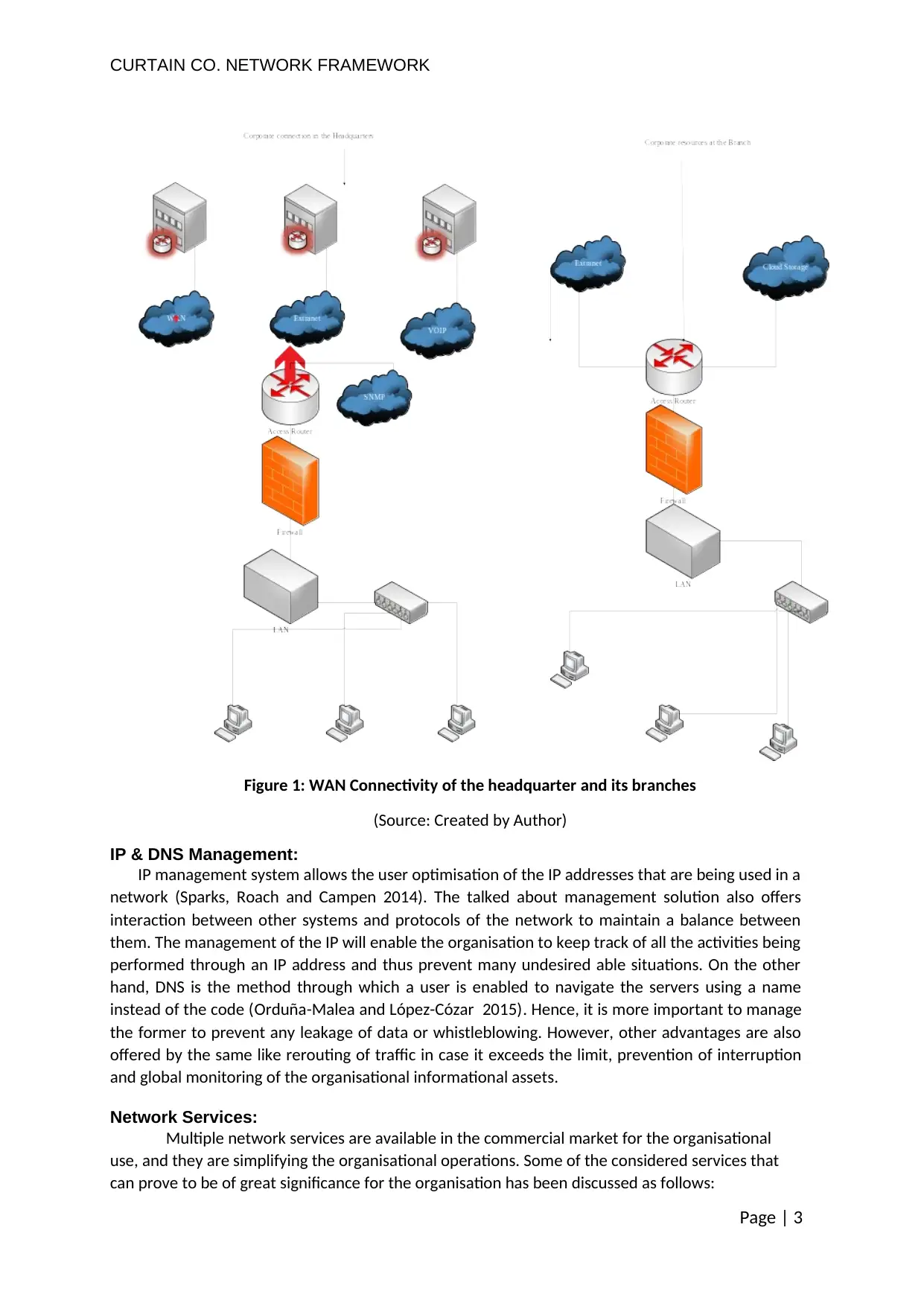
CURTAIN CO. NETWORK FRAMEWORK
Figure 1: WAN Connectivity of the headquarter and its branches
(Source: Created by Author)
IP & DNS Management:
IP management system allows the user optimisation of the IP addresses that are being used in a
network (Sparks, Roach and Campen 2014). The talked about management solution also offers
interaction between other systems and protocols of the network to maintain a balance between
them. The management of the IP will enable the organisation to keep track of all the activities being
performed through an IP address and thus prevent many undesired able situations. On the other
hand, DNS is the method through which a user is enabled to navigate the servers using a name
instead of the code (Orduña-Malea and López-Cózar 2015). Hence, it is more important to manage
the former to prevent any leakage of data or whistleblowing. However, other advantages are also
offered by the same like rerouting of traffic in case it exceeds the limit, prevention of interruption
and global monitoring of the organisational informational assets.
Network Services:
Multiple network services are available in the commercial market for the organisational
use, and they are simplifying the organisational operations. Some of the considered services that
can prove to be of great significance for the organisation has been discussed as follows:
Page | 3
Figure 1: WAN Connectivity of the headquarter and its branches
(Source: Created by Author)
IP & DNS Management:
IP management system allows the user optimisation of the IP addresses that are being used in a
network (Sparks, Roach and Campen 2014). The talked about management solution also offers
interaction between other systems and protocols of the network to maintain a balance between
them. The management of the IP will enable the organisation to keep track of all the activities being
performed through an IP address and thus prevent many undesired able situations. On the other
hand, DNS is the method through which a user is enabled to navigate the servers using a name
instead of the code (Orduña-Malea and López-Cózar 2015). Hence, it is more important to manage
the former to prevent any leakage of data or whistleblowing. However, other advantages are also
offered by the same like rerouting of traffic in case it exceeds the limit, prevention of interruption
and global monitoring of the organisational informational assets.
Network Services:
Multiple network services are available in the commercial market for the organisational
use, and they are simplifying the organisational operations. Some of the considered services that
can prove to be of great significance for the organisation has been discussed as follows:
Page | 3
⊘ This is a preview!⊘
Do you want full access?
Subscribe today to unlock all pages.

Trusted by 1+ million students worldwide
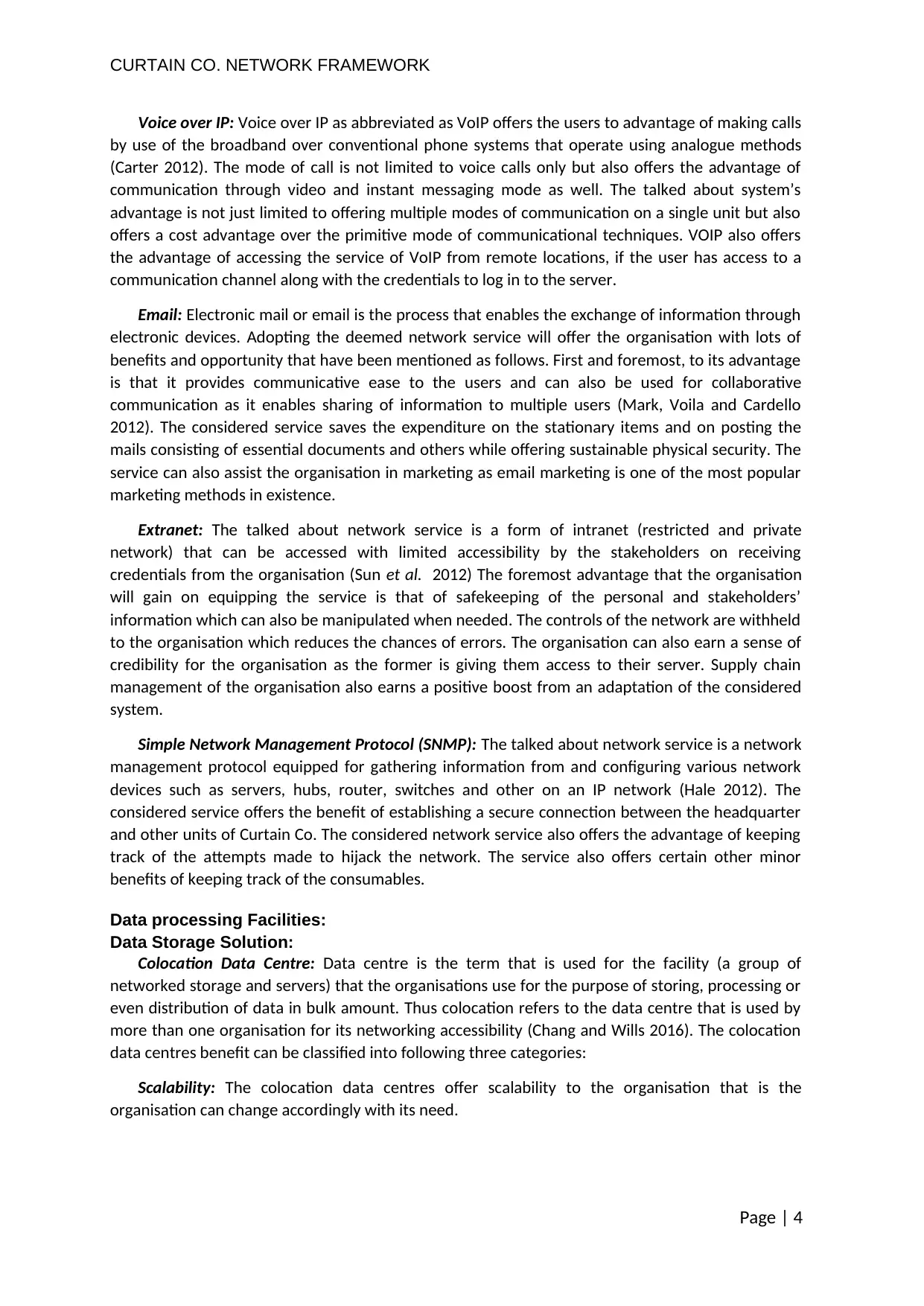
CURTAIN CO. NETWORK FRAMEWORK
Voice over IP: Voice over IP as abbreviated as VoIP offers the users to advantage of making calls
by use of the broadband over conventional phone systems that operate using analogue methods
(Carter 2012). The mode of call is not limited to voice calls only but also offers the advantage of
communication through video and instant messaging mode as well. The talked about system’s
advantage is not just limited to offering multiple modes of communication on a single unit but also
offers a cost advantage over the primitive mode of communicational techniques. VOIP also offers
the advantage of accessing the service of VoIP from remote locations, if the user has access to a
communication channel along with the credentials to log in to the server.
Email: Electronic mail or email is the process that enables the exchange of information through
electronic devices. Adopting the deemed network service will offer the organisation with lots of
benefits and opportunity that have been mentioned as follows. First and foremost, to its advantage
is that it provides communicative ease to the users and can also be used for collaborative
communication as it enables sharing of information to multiple users (Mark, Voila and Cardello
2012). The considered service saves the expenditure on the stationary items and on posting the
mails consisting of essential documents and others while offering sustainable physical security. The
service can also assist the organisation in marketing as email marketing is one of the most popular
marketing methods in existence.
Extranet: The talked about network service is a form of intranet (restricted and private
network) that can be accessed with limited accessibility by the stakeholders on receiving
credentials from the organisation (Sun et al. 2012) The foremost advantage that the organisation
will gain on equipping the service is that of safekeeping of the personal and stakeholders’
information which can also be manipulated when needed. The controls of the network are withheld
to the organisation which reduces the chances of errors. The organisation can also earn a sense of
credibility for the organisation as the former is giving them access to their server. Supply chain
management of the organisation also earns a positive boost from an adaptation of the considered
system.
Simple Network Management Protocol (SNMP): The talked about network service is a network
management protocol equipped for gathering information from and configuring various network
devices such as servers, hubs, router, switches and other on an IP network (Hale 2012). The
considered service offers the benefit of establishing a secure connection between the headquarter
and other units of Curtain Co. The considered network service also offers the advantage of keeping
track of the attempts made to hijack the network. The service also offers certain other minor
benefits of keeping track of the consumables.
Data processing Facilities:
Data Storage Solution:
Colocation Data Centre: Data centre is the term that is used for the facility (a group of
networked storage and servers) that the organisations use for the purpose of storing, processing or
even distribution of data in bulk amount. Thus colocation refers to the data centre that is used by
more than one organisation for its networking accessibility (Chang and Wills 2016). The colocation
data centres benefit can be classified into following three categories:
Scalability: The colocation data centres offer scalability to the organisation that is the
organisation can change accordingly with its need.
Page | 4
Voice over IP: Voice over IP as abbreviated as VoIP offers the users to advantage of making calls
by use of the broadband over conventional phone systems that operate using analogue methods
(Carter 2012). The mode of call is not limited to voice calls only but also offers the advantage of
communication through video and instant messaging mode as well. The talked about system’s
advantage is not just limited to offering multiple modes of communication on a single unit but also
offers a cost advantage over the primitive mode of communicational techniques. VOIP also offers
the advantage of accessing the service of VoIP from remote locations, if the user has access to a
communication channel along with the credentials to log in to the server.
Email: Electronic mail or email is the process that enables the exchange of information through
electronic devices. Adopting the deemed network service will offer the organisation with lots of
benefits and opportunity that have been mentioned as follows. First and foremost, to its advantage
is that it provides communicative ease to the users and can also be used for collaborative
communication as it enables sharing of information to multiple users (Mark, Voila and Cardello
2012). The considered service saves the expenditure on the stationary items and on posting the
mails consisting of essential documents and others while offering sustainable physical security. The
service can also assist the organisation in marketing as email marketing is one of the most popular
marketing methods in existence.
Extranet: The talked about network service is a form of intranet (restricted and private
network) that can be accessed with limited accessibility by the stakeholders on receiving
credentials from the organisation (Sun et al. 2012) The foremost advantage that the organisation
will gain on equipping the service is that of safekeeping of the personal and stakeholders’
information which can also be manipulated when needed. The controls of the network are withheld
to the organisation which reduces the chances of errors. The organisation can also earn a sense of
credibility for the organisation as the former is giving them access to their server. Supply chain
management of the organisation also earns a positive boost from an adaptation of the considered
system.
Simple Network Management Protocol (SNMP): The talked about network service is a network
management protocol equipped for gathering information from and configuring various network
devices such as servers, hubs, router, switches and other on an IP network (Hale 2012). The
considered service offers the benefit of establishing a secure connection between the headquarter
and other units of Curtain Co. The considered network service also offers the advantage of keeping
track of the attempts made to hijack the network. The service also offers certain other minor
benefits of keeping track of the consumables.
Data processing Facilities:
Data Storage Solution:
Colocation Data Centre: Data centre is the term that is used for the facility (a group of
networked storage and servers) that the organisations use for the purpose of storing, processing or
even distribution of data in bulk amount. Thus colocation refers to the data centre that is used by
more than one organisation for its networking accessibility (Chang and Wills 2016). The colocation
data centres benefit can be classified into following three categories:
Scalability: The colocation data centres offer scalability to the organisation that is the
organisation can change accordingly with its need.
Page | 4
Paraphrase This Document
Need a fresh take? Get an instant paraphrase of this document with our AI Paraphraser
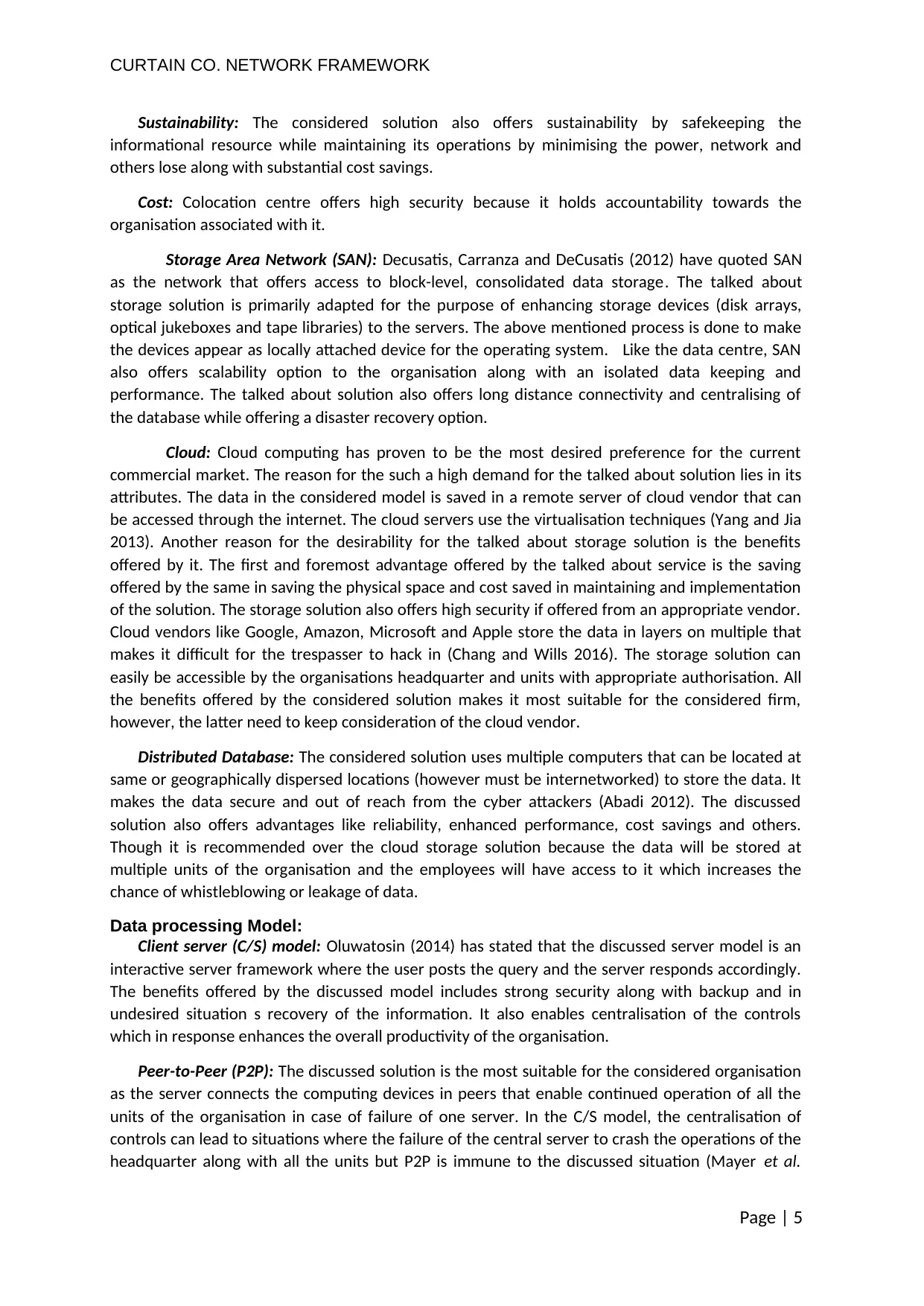
CURTAIN CO. NETWORK FRAMEWORK
Sustainability: The considered solution also offers sustainability by safekeeping the
informational resource while maintaining its operations by minimising the power, network and
others lose along with substantial cost savings.
Cost: Colocation centre offers high security because it holds accountability towards the
organisation associated with it.
Storage Area Network (SAN): Decusatis, Carranza and DeCusatis (2012) have quoted SAN
as the network that offers access to block-level, consolidated data storage. The talked about
storage solution is primarily adapted for the purpose of enhancing storage devices (disk arrays,
optical jukeboxes and tape libraries) to the servers. The above mentioned process is done to make
the devices appear as locally attached device for the operating system. Like the data centre, SAN
also offers scalability option to the organisation along with an isolated data keeping and
performance. The talked about solution also offers long distance connectivity and centralising of
the database while offering a disaster recovery option.
Cloud: Cloud computing has proven to be the most desired preference for the current
commercial market. The reason for the such a high demand for the talked about solution lies in its
attributes. The data in the considered model is saved in a remote server of cloud vendor that can
be accessed through the internet. The cloud servers use the virtualisation techniques (Yang and Jia
2013). Another reason for the desirability for the talked about storage solution is the benefits
offered by it. The first and foremost advantage offered by the talked about service is the saving
offered by the same in saving the physical space and cost saved in maintaining and implementation
of the solution. The storage solution also offers high security if offered from an appropriate vendor.
Cloud vendors like Google, Amazon, Microsoft and Apple store the data in layers on multiple that
makes it difficult for the trespasser to hack in (Chang and Wills 2016). The storage solution can
easily be accessible by the organisations headquarter and units with appropriate authorisation. All
the benefits offered by the considered solution makes it most suitable for the considered firm,
however, the latter need to keep consideration of the cloud vendor.
Distributed Database: The considered solution uses multiple computers that can be located at
same or geographically dispersed locations (however must be internetworked) to store the data. It
makes the data secure and out of reach from the cyber attackers (Abadi 2012). The discussed
solution also offers advantages like reliability, enhanced performance, cost savings and others.
Though it is recommended over the cloud storage solution because the data will be stored at
multiple units of the organisation and the employees will have access to it which increases the
chance of whistleblowing or leakage of data.
Data processing Model:
Client server (C/S) model: Oluwatosin (2014) has stated that the discussed server model is an
interactive server framework where the user posts the query and the server responds accordingly.
The benefits offered by the discussed model includes strong security along with backup and in
undesired situation s recovery of the information. It also enables centralisation of the controls
which in response enhances the overall productivity of the organisation.
Peer-to-Peer (P2P): The discussed solution is the most suitable for the considered organisation
as the server connects the computing devices in peers that enable continued operation of all the
units of the organisation in case of failure of one server. In the C/S model, the centralisation of
controls can lead to situations where the failure of the central server to crash the operations of the
headquarter along with all the units but P2P is immune to the discussed situation (Mayer et al.
Page | 5
Sustainability: The considered solution also offers sustainability by safekeeping the
informational resource while maintaining its operations by minimising the power, network and
others lose along with substantial cost savings.
Cost: Colocation centre offers high security because it holds accountability towards the
organisation associated with it.
Storage Area Network (SAN): Decusatis, Carranza and DeCusatis (2012) have quoted SAN
as the network that offers access to block-level, consolidated data storage. The talked about
storage solution is primarily adapted for the purpose of enhancing storage devices (disk arrays,
optical jukeboxes and tape libraries) to the servers. The above mentioned process is done to make
the devices appear as locally attached device for the operating system. Like the data centre, SAN
also offers scalability option to the organisation along with an isolated data keeping and
performance. The talked about solution also offers long distance connectivity and centralising of
the database while offering a disaster recovery option.
Cloud: Cloud computing has proven to be the most desired preference for the current
commercial market. The reason for the such a high demand for the talked about solution lies in its
attributes. The data in the considered model is saved in a remote server of cloud vendor that can
be accessed through the internet. The cloud servers use the virtualisation techniques (Yang and Jia
2013). Another reason for the desirability for the talked about storage solution is the benefits
offered by it. The first and foremost advantage offered by the talked about service is the saving
offered by the same in saving the physical space and cost saved in maintaining and implementation
of the solution. The storage solution also offers high security if offered from an appropriate vendor.
Cloud vendors like Google, Amazon, Microsoft and Apple store the data in layers on multiple that
makes it difficult for the trespasser to hack in (Chang and Wills 2016). The storage solution can
easily be accessible by the organisations headquarter and units with appropriate authorisation. All
the benefits offered by the considered solution makes it most suitable for the considered firm,
however, the latter need to keep consideration of the cloud vendor.
Distributed Database: The considered solution uses multiple computers that can be located at
same or geographically dispersed locations (however must be internetworked) to store the data. It
makes the data secure and out of reach from the cyber attackers (Abadi 2012). The discussed
solution also offers advantages like reliability, enhanced performance, cost savings and others.
Though it is recommended over the cloud storage solution because the data will be stored at
multiple units of the organisation and the employees will have access to it which increases the
chance of whistleblowing or leakage of data.
Data processing Model:
Client server (C/S) model: Oluwatosin (2014) has stated that the discussed server model is an
interactive server framework where the user posts the query and the server responds accordingly.
The benefits offered by the discussed model includes strong security along with backup and in
undesired situation s recovery of the information. It also enables centralisation of the controls
which in response enhances the overall productivity of the organisation.
Peer-to-Peer (P2P): The discussed solution is the most suitable for the considered organisation
as the server connects the computing devices in peers that enable continued operation of all the
units of the organisation in case of failure of one server. In the C/S model, the centralisation of
controls can lead to situations where the failure of the central server to crash the operations of the
headquarter along with all the units but P2P is immune to the discussed situation (Mayer et al.
Page | 5
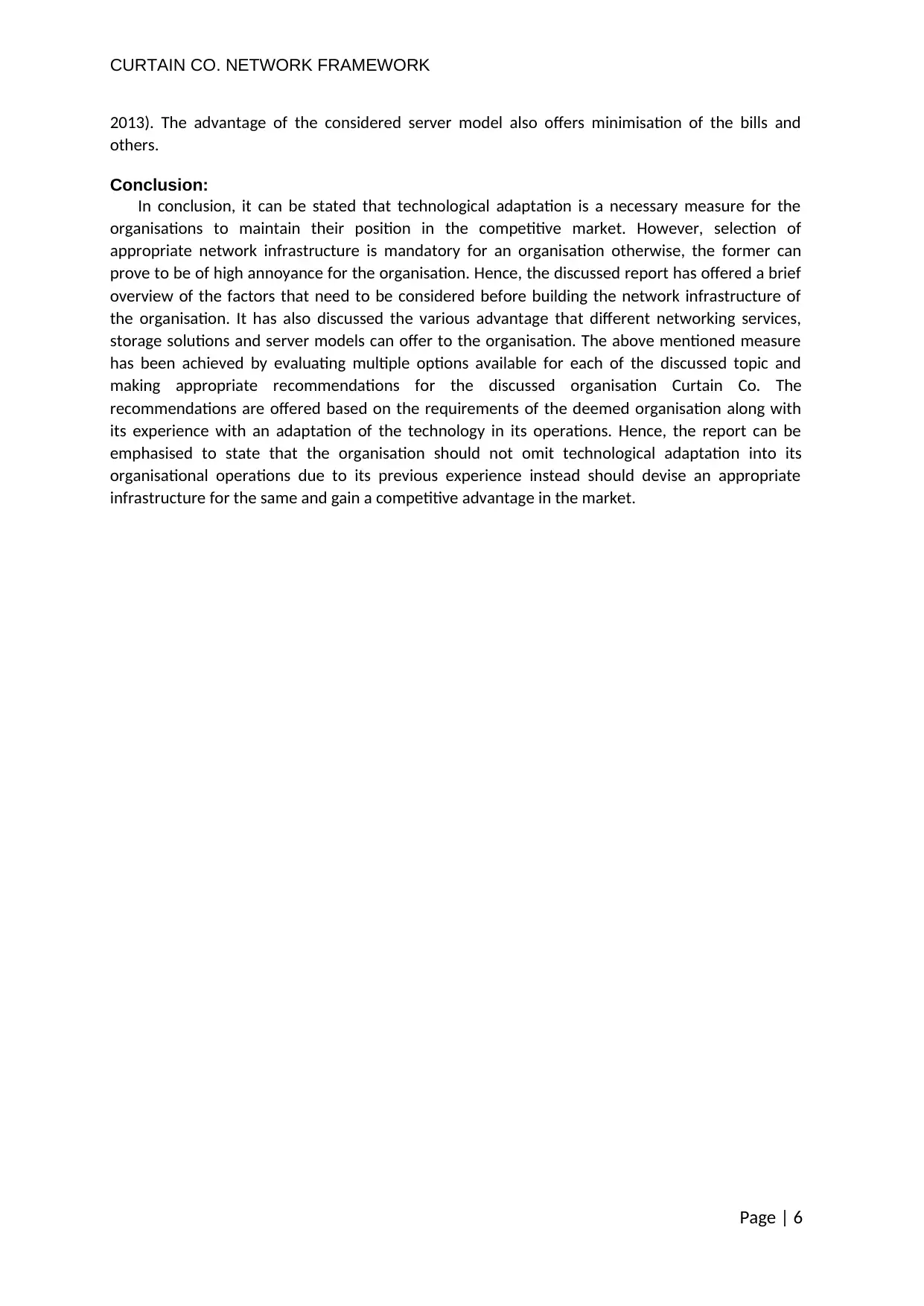
CURTAIN CO. NETWORK FRAMEWORK
2013). The advantage of the considered server model also offers minimisation of the bills and
others.
Conclusion:
In conclusion, it can be stated that technological adaptation is a necessary measure for the
organisations to maintain their position in the competitive market. However, selection of
appropriate network infrastructure is mandatory for an organisation otherwise, the former can
prove to be of high annoyance for the organisation. Hence, the discussed report has offered a brief
overview of the factors that need to be considered before building the network infrastructure of
the organisation. It has also discussed the various advantage that different networking services,
storage solutions and server models can offer to the organisation. The above mentioned measure
has been achieved by evaluating multiple options available for each of the discussed topic and
making appropriate recommendations for the discussed organisation Curtain Co. The
recommendations are offered based on the requirements of the deemed organisation along with
its experience with an adaptation of the technology in its operations. Hence, the report can be
emphasised to state that the organisation should not omit technological adaptation into its
organisational operations due to its previous experience instead should devise an appropriate
infrastructure for the same and gain a competitive advantage in the market.
Page | 6
2013). The advantage of the considered server model also offers minimisation of the bills and
others.
Conclusion:
In conclusion, it can be stated that technological adaptation is a necessary measure for the
organisations to maintain their position in the competitive market. However, selection of
appropriate network infrastructure is mandatory for an organisation otherwise, the former can
prove to be of high annoyance for the organisation. Hence, the discussed report has offered a brief
overview of the factors that need to be considered before building the network infrastructure of
the organisation. It has also discussed the various advantage that different networking services,
storage solutions and server models can offer to the organisation. The above mentioned measure
has been achieved by evaluating multiple options available for each of the discussed topic and
making appropriate recommendations for the discussed organisation Curtain Co. The
recommendations are offered based on the requirements of the deemed organisation along with
its experience with an adaptation of the technology in its operations. Hence, the report can be
emphasised to state that the organisation should not omit technological adaptation into its
organisational operations due to its previous experience instead should devise an appropriate
infrastructure for the same and gain a competitive advantage in the market.
Page | 6
⊘ This is a preview!⊘
Do you want full access?
Subscribe today to unlock all pages.

Trusted by 1+ million students worldwide
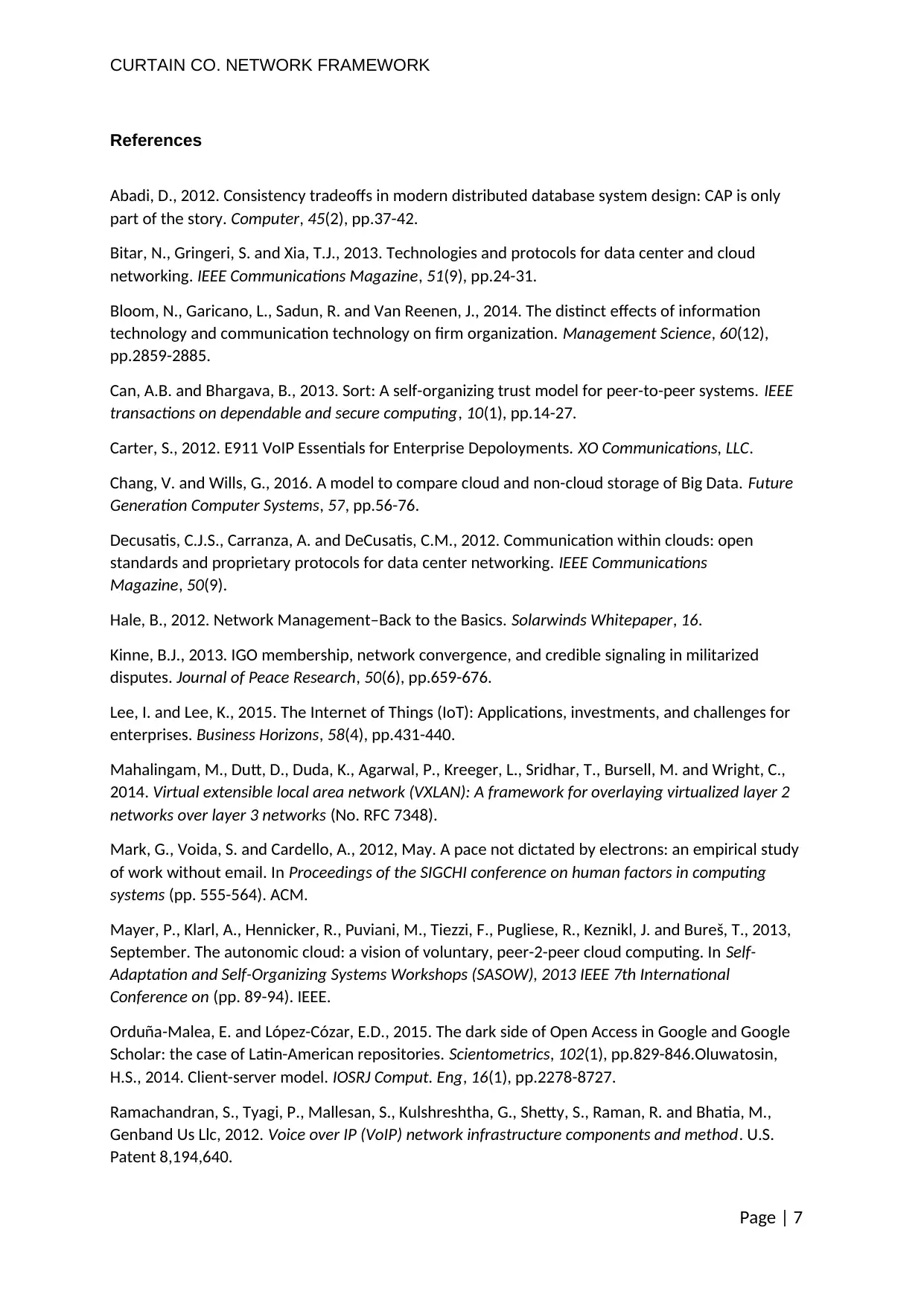
CURTAIN CO. NETWORK FRAMEWORK
References
Abadi, D., 2012. Consistency tradeoffs in modern distributed database system design: CAP is only
part of the story. Computer, 45(2), pp.37-42.
Bitar, N., Gringeri, S. and Xia, T.J., 2013. Technologies and protocols for data center and cloud
networking. IEEE Communications Magazine, 51(9), pp.24-31.
Bloom, N., Garicano, L., Sadun, R. and Van Reenen, J., 2014. The distinct effects of information
technology and communication technology on firm organization. Management Science, 60(12),
pp.2859-2885.
Can, A.B. and Bhargava, B., 2013. Sort: A self-organizing trust model for peer-to-peer systems. IEEE
transactions on dependable and secure computing, 10(1), pp.14-27.
Carter, S., 2012. E911 VoIP Essentials for Enterprise Depoloyments. XO Communications, LLC.
Chang, V. and Wills, G., 2016. A model to compare cloud and non-cloud storage of Big Data. Future
Generation Computer Systems, 57, pp.56-76.
Decusatis, C.J.S., Carranza, A. and DeCusatis, C.M., 2012. Communication within clouds: open
standards and proprietary protocols for data center networking. IEEE Communications
Magazine, 50(9).
Hale, B., 2012. Network Management–Back to the Basics. Solarwinds Whitepaper, 16.
Kinne, B.J., 2013. IGO membership, network convergence, and credible signaling in militarized
disputes. Journal of Peace Research, 50(6), pp.659-676.
Lee, I. and Lee, K., 2015. The Internet of Things (IoT): Applications, investments, and challenges for
enterprises. Business Horizons, 58(4), pp.431-440.
Mahalingam, M., Dutt, D., Duda, K., Agarwal, P., Kreeger, L., Sridhar, T., Bursell, M. and Wright, C.,
2014. Virtual extensible local area network (VXLAN): A framework for overlaying virtualized layer 2
networks over layer 3 networks (No. RFC 7348).
Mark, G., Voida, S. and Cardello, A., 2012, May. A pace not dictated by electrons: an empirical study
of work without email. In Proceedings of the SIGCHI conference on human factors in computing
systems (pp. 555-564). ACM.
Mayer, P., Klarl, A., Hennicker, R., Puviani, M., Tiezzi, F., Pugliese, R., Keznikl, J. and Bureš, T., 2013,
September. The autonomic cloud: a vision of voluntary, peer-2-peer cloud computing. In Self-
Adaptation and Self-Organizing Systems Workshops (SASOW), 2013 IEEE 7th International
Conference on (pp. 89-94). IEEE.
Orduña-Malea, E. and López-Cózar, E.D., 2015. The dark side of Open Access in Google and Google
Scholar: the case of Latin-American repositories. Scientometrics, 102(1), pp.829-846.Oluwatosin,
H.S., 2014. Client-server model. IOSRJ Comput. Eng, 16(1), pp.2278-8727.
Ramachandran, S., Tyagi, P., Mallesan, S., Kulshreshtha, G., Shetty, S., Raman, R. and Bhatia, M.,
Genband Us Llc, 2012. Voice over IP (VoIP) network infrastructure components and method. U.S.
Patent 8,194,640.
Page | 7
References
Abadi, D., 2012. Consistency tradeoffs in modern distributed database system design: CAP is only
part of the story. Computer, 45(2), pp.37-42.
Bitar, N., Gringeri, S. and Xia, T.J., 2013. Technologies and protocols for data center and cloud
networking. IEEE Communications Magazine, 51(9), pp.24-31.
Bloom, N., Garicano, L., Sadun, R. and Van Reenen, J., 2014. The distinct effects of information
technology and communication technology on firm organization. Management Science, 60(12),
pp.2859-2885.
Can, A.B. and Bhargava, B., 2013. Sort: A self-organizing trust model for peer-to-peer systems. IEEE
transactions on dependable and secure computing, 10(1), pp.14-27.
Carter, S., 2012. E911 VoIP Essentials for Enterprise Depoloyments. XO Communications, LLC.
Chang, V. and Wills, G., 2016. A model to compare cloud and non-cloud storage of Big Data. Future
Generation Computer Systems, 57, pp.56-76.
Decusatis, C.J.S., Carranza, A. and DeCusatis, C.M., 2012. Communication within clouds: open
standards and proprietary protocols for data center networking. IEEE Communications
Magazine, 50(9).
Hale, B., 2012. Network Management–Back to the Basics. Solarwinds Whitepaper, 16.
Kinne, B.J., 2013. IGO membership, network convergence, and credible signaling in militarized
disputes. Journal of Peace Research, 50(6), pp.659-676.
Lee, I. and Lee, K., 2015. The Internet of Things (IoT): Applications, investments, and challenges for
enterprises. Business Horizons, 58(4), pp.431-440.
Mahalingam, M., Dutt, D., Duda, K., Agarwal, P., Kreeger, L., Sridhar, T., Bursell, M. and Wright, C.,
2014. Virtual extensible local area network (VXLAN): A framework for overlaying virtualized layer 2
networks over layer 3 networks (No. RFC 7348).
Mark, G., Voida, S. and Cardello, A., 2012, May. A pace not dictated by electrons: an empirical study
of work without email. In Proceedings of the SIGCHI conference on human factors in computing
systems (pp. 555-564). ACM.
Mayer, P., Klarl, A., Hennicker, R., Puviani, M., Tiezzi, F., Pugliese, R., Keznikl, J. and Bureš, T., 2013,
September. The autonomic cloud: a vision of voluntary, peer-2-peer cloud computing. In Self-
Adaptation and Self-Organizing Systems Workshops (SASOW), 2013 IEEE 7th International
Conference on (pp. 89-94). IEEE.
Orduña-Malea, E. and López-Cózar, E.D., 2015. The dark side of Open Access in Google and Google
Scholar: the case of Latin-American repositories. Scientometrics, 102(1), pp.829-846.Oluwatosin,
H.S., 2014. Client-server model. IOSRJ Comput. Eng, 16(1), pp.2278-8727.
Ramachandran, S., Tyagi, P., Mallesan, S., Kulshreshtha, G., Shetty, S., Raman, R. and Bhatia, M.,
Genband Us Llc, 2012. Voice over IP (VoIP) network infrastructure components and method. U.S.
Patent 8,194,640.
Page | 7
Paraphrase This Document
Need a fresh take? Get an instant paraphrase of this document with our AI Paraphraser
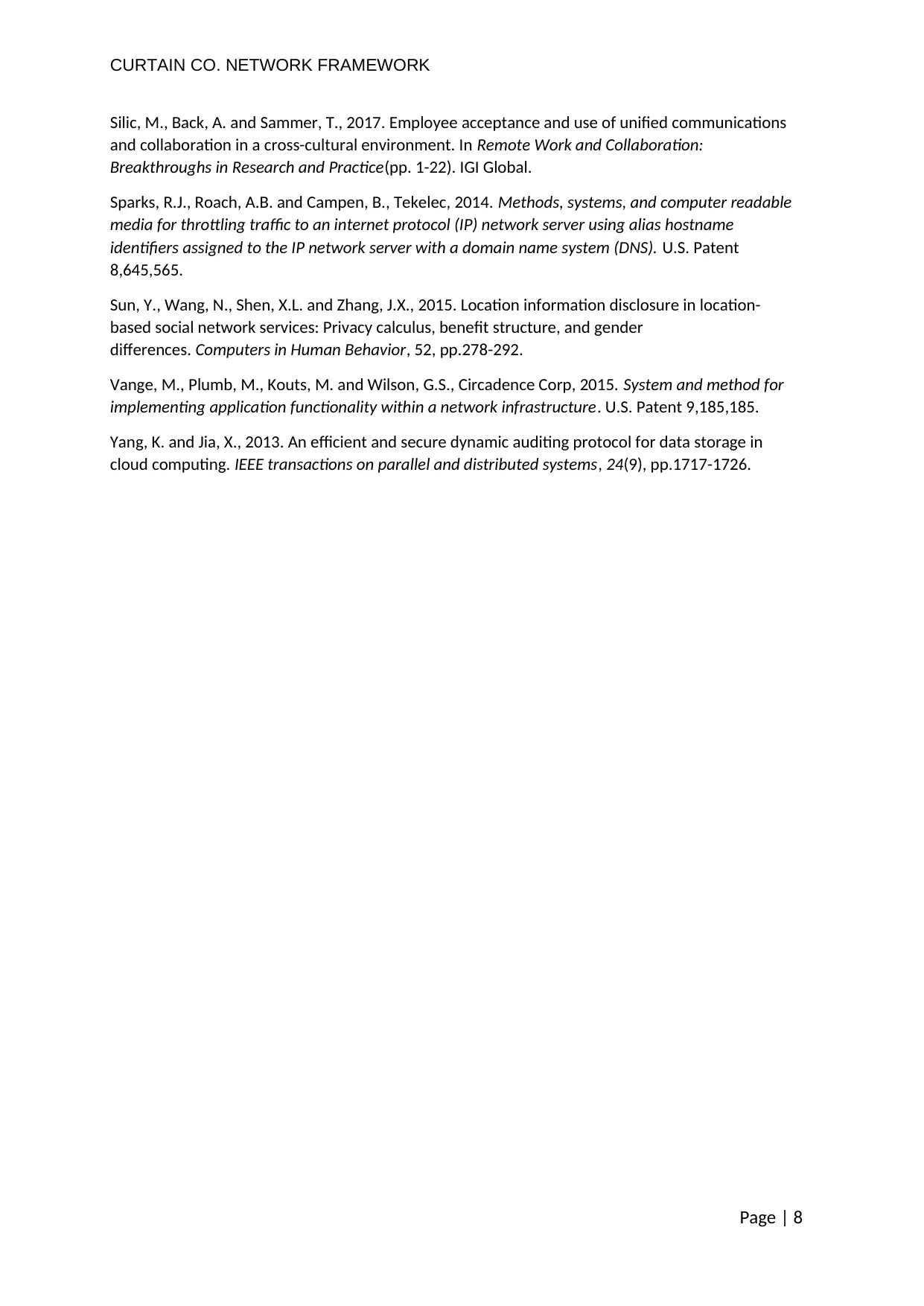
CURTAIN CO. NETWORK FRAMEWORK
Silic, M., Back, A. and Sammer, T., 2017. Employee acceptance and use of unified communications
and collaboration in a cross-cultural environment. In Remote Work and Collaboration:
Breakthroughs in Research and Practice(pp. 1-22). IGI Global.
Sparks, R.J., Roach, A.B. and Campen, B., Tekelec, 2014. Methods, systems, and computer readable
media for throttling traffic to an internet protocol (IP) network server using alias hostname
identifiers assigned to the IP network server with a domain name system (DNS). U.S. Patent
8,645,565.
Sun, Y., Wang, N., Shen, X.L. and Zhang, J.X., 2015. Location information disclosure in location-
based social network services: Privacy calculus, benefit structure, and gender
differences. Computers in Human Behavior, 52, pp.278-292.
Vange, M., Plumb, M., Kouts, M. and Wilson, G.S., Circadence Corp, 2015. System and method for
implementing application functionality within a network infrastructure. U.S. Patent 9,185,185.
Yang, K. and Jia, X., 2013. An efficient and secure dynamic auditing protocol for data storage in
cloud computing. IEEE transactions on parallel and distributed systems, 24(9), pp.1717-1726.
Page | 8
Silic, M., Back, A. and Sammer, T., 2017. Employee acceptance and use of unified communications
and collaboration in a cross-cultural environment. In Remote Work and Collaboration:
Breakthroughs in Research and Practice(pp. 1-22). IGI Global.
Sparks, R.J., Roach, A.B. and Campen, B., Tekelec, 2014. Methods, systems, and computer readable
media for throttling traffic to an internet protocol (IP) network server using alias hostname
identifiers assigned to the IP network server with a domain name system (DNS). U.S. Patent
8,645,565.
Sun, Y., Wang, N., Shen, X.L. and Zhang, J.X., 2015. Location information disclosure in location-
based social network services: Privacy calculus, benefit structure, and gender
differences. Computers in Human Behavior, 52, pp.278-292.
Vange, M., Plumb, M., Kouts, M. and Wilson, G.S., Circadence Corp, 2015. System and method for
implementing application functionality within a network infrastructure. U.S. Patent 9,185,185.
Yang, K. and Jia, X., 2013. An efficient and secure dynamic auditing protocol for data storage in
cloud computing. IEEE transactions on parallel and distributed systems, 24(9), pp.1717-1726.
Page | 8
1 out of 11
Related Documents
Your All-in-One AI-Powered Toolkit for Academic Success.
+13062052269
info@desklib.com
Available 24*7 on WhatsApp / Email
![[object Object]](/_next/static/media/star-bottom.7253800d.svg)
Unlock your academic potential
Copyright © 2020–2025 A2Z Services. All Rights Reserved. Developed and managed by ZUCOL.





